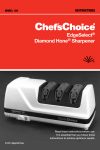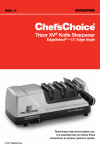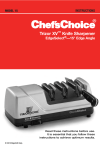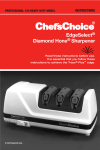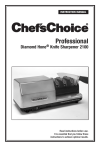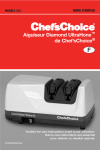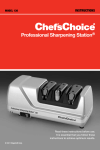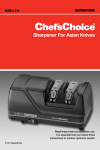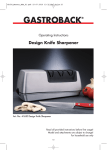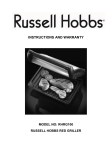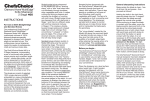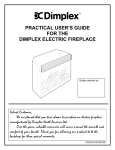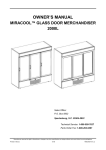Download Diamond UltraHone® Sharpener
Transcript
MODEL 312 Instructions Diamond UltraHone® Sharpener Read these instructions before use. It is essential that you follow these instructions to achieve optimum results. © 2014 EdgeCraft Corp. Important Safeguards When using electrical appliances, basic safety precautions should always be followed including the following: 1. Read all instructions. Every user should read this manual. 2. To protect against electrical hazards do not immerse the Chef’sChoice® Model 312 in water or other liquid. 3. Make sure that only clean knife blades are inserted in the Model 312. 4. Unplug from outlet when not in use, before putting on or taking off parts, and before cleaning. 5. Avoid contacting moving parts. 6. Do not operate any appliance with a damaged cord or plug or after the appliance malfunctions, or is dropped or damaged in any manner. U.S. customers: You may return your sharpener to EdgeCraft’s factory for service where the cost of repair or electrical or mechanical adjustment can be estimated. When the electrical cord on this appliance is damaged, it must be replaced by the Chef’sChoice distributor or other qualified service to avoid the danger of electrical shock. Outside U.S.: Please return your sharpener to your local distributor where the cost of repair or electrical or mechanical adjustment can be estimated. If the supply cord of this appliance is damaged, it must be replaced by a repair facility appointed by the manufacturer because special tools are required. Please consult your Chef’sChoice distributor. 7. CAUTION! This appliance may be fitted with a polarized plug (one blade is wider than the other). To reduce the risk of electric shock, this plug will fit in a polarized outlet only one way. If the plug does not fit fully in the outlet, reverse the plug. If it still does not fit, contact a qualified electrician. Do not modify the plug in anyway. 8. The use of attachments not recommended or sold by EdgeCraft Corporation may cause fire, electric shock, or injury. 9. The Chef’sChoice® Model 312 is designed to sharpen household knives, pocket knives and selected sports knives. Do not attempt to sharpen scissors, ax blades or any blade that does not fit freely in the slots. 10.Do not let the cord hang over edge of table or counter or touch hot surfaces. 11.When in the “ON” position (Red flash on switch is exposed when “ON”) the Chef’sChoice® sharpener should always be on a stable countertop or table. 12.WARNING: KNIVES PROPERLY SHARPENED ON YOUR CHEF’SCHOICE® WILL BE SHARPER THAN YOU EXPECT. TO AVOID INJURY USE AND HANDLE THEM WITH EXTREME CARE. DO NOT CUT TOWARD ANY PART OF YOUR FINGERS, HAND OR BODY. DO NOT RUN FINGER ALONG EDGE. STORE IN A SAFE MANNER. 13.Do not use outdoors. 14.Close supervision is necessary when any appliance is used by or near children or the infirm. 15.Do not use honing oils, water, or any other lubricant with the Model 312. 16.For household use only. 17. SAVE THESE INSTRUCTIONS. 2 You Made a Good Choice Professional chefs and serious cooks worldwide rely on Chef’sChoice® Diamond Hone® sharpeners to maintain the edges of their favorite knives at better than factory sharpness and durability. Chef’sChoice® sharpeners are known for their consistent foolproof performance, ease of use, and ability to create ultra sharp edges on quality cutlery with minimal removal of metal. The Chef’sChoice® Model 312 incorporates the latest technology developed by Chef’sChoice® based on micron sized diamonds to ultra hone your knife edge to astonishing sharpness. You will find it fast and simple to use. The two stage design of Model 312 sharpens/hones the edge first with fine diamonds to create a first bevel before honing with ultrafine diamonds at a slightly larger angle to develop an unusually sharp but durable edge. Diamonds, the hardest known materials can sharpen knives made of any metal including the hardest carbon, stainless and super alloy steels. You will find renewed joy in using your favorite knives once sharpened in the Model 312. The edges will be sharper and they will stay sharp longer than conventional or hollow ground edges. Remember a sharp knife is a safer knife because it requires less effort to cut or slice. The Model 312 will reward you with years of added culinary pleasure and bring extra appeal to each gourment creation. Enjoy. 3 Understanding the Model 312 Diamond UltraHone® Sharpener This unique Chef’sChoice® Diamond UltraHone® Sharpener is designed to sharpen knives with either straight or serrated edges. This two (2) stage sharpener has two precision sharpening / honing stages, one with fine and the other with ultrafine 100% diamond abrasive. This combination can be used to create either an ultra sharp, smooth faceted edge for effortless cutting and presentations or one with a selected amount of residual “bite”. The sharpening and honing actions are controlled by using precisely angled guides for the blade and precisely matched conically surfaced abrasive disks. The sharpening angle is slightly larger in Stage 2 than in Stage 1. The sharpening rate is carefully controlled by the size of diamonds used and by unique internal springs that limit the amount of pressure that can be applied to the edge by the abrasive disks. Fine diamond-coated conical disks in Stage 1 create microgrooves along the facets on each side of the edge establishing the first angled bevel of the edge. In Stage 2 precision disks coated with micron sized diamonds gently hone and polish the facets immediately adjacent to the edge creating a microbevel along a microscopically thin straight and polished edge. The honing action simultaneously polishes and sharpens the boundaries of those microgrooves created by the diamond abrasives in Stage 1 adjacent to the edge until they become sharp micro flutes that will assist the cutting action with “difficult to cut” materials. This unique two stage design gives you an extremely sharp edge and because of the second angle microbevel, you will notice that your knives stay sharp longer than those sharpened by conventional means. The following sections describe the general procedures for optimal sharpening. One of the important advantages of using the Model 312 is that you can hone and polish your knives to razor sharp edges as often as needed and yet experience little knife wear compared to older sharpening methods. Resharpening can commonly be done by using just the gentle ultra honing action of Stage 2. (See Resharpening Section). Each sharpening Stage is equipped with gray flexible plastic springs that are positioned over the sharpening disks (see Figure 1) to hold the face of your knife securely against the precision guides in the right and left slots of each stage during sharpening. 4 Unless you have special blades designed to be sharpened primarily on one side of the edge (such as Asian Kataba blades) you will want to sharpen equally in the right and left slots of each stage that you use. This will insure that the facets on each side of the edge are of equal size and that the edge will cut straight at all times. When sharpening in either stage the knife should on sequential strokes be pulled alternately through the left slot and the right slot of that Stage. Generally a few pairs of pulls (alternating in the left and right slots) will be adequate in each stage (see subsequent sections for more detail). Always operate the sharpener from the front side with the switch facing you. Hold the blade horizontal and level, slide it down between the plastic spring and the guide plane while pulling it toward you at a uniform rate as it contacts the sharpening or honing disk. You will be able to feel and hear the contact with the disk as it is made. Always keep the blade moving uniformly through each stage; do not stop the pull in mid stroke. The time for each sharpening stroke can be less for shorter blades and more for longer blades. Never operate the sharpener from the back side. Use just enough downward pressure when sharpening to insure uniform and consistent contact of the blade with the abrasive disks on each stroke. The sharpening pressure is controlled by the internal springs positioned between the abrasive disks. Additional pressure is unnecessary and will not speed the sharpening process. Avoid cutting into the plastic enclosure. Accidental cutting into the enclosure will not functionally impact operations of the sharpener or damage the edge. Figure 1 below identifies each of the two stages as described further in the following sections. Flexible Positioning Stage 1 Springs Stage 2 Handle Bolster Heel Tip Figure 1. Model 312 Diamond Hone® Sharpener. Edge Figure 2. Typical kitchen knife. 5 The Chef’sChoice® Model 312 is designed to sharpen either Straight edge or Serrated edge blades. Follow these instructions for optimum results. Procedure for Sharpening Straight Edge Blades Straight Edge Blades: Sharpening First Time Always clean the blade free of dirt, oil and food before inserting into sharpener. Before you turn on the power, slip a knife blade smoothly into the slot between the left angle guide of Stage 1 and the plastic spring. Do not twist the knife. (See Figure 3.) Move the blade down in the slot until you feel it contact the diamond disk. Pull it towards you lifting the handle slightly as you approach the tip. This will give you a feel for the spring tension. Remove the knife and press the Power Switch. A red “indicator” on the switch appears when this switch is turned “ON.” Stage 1: If you are sharpening a straight-edge knife for the first time, start in Stage 1. Pull the knife once through the left slot of Stage 1 (Figure 3) by slipping the blade between the left plastic angle guide and the plastic spring while pulling the blade toward you and simultaneously moving the blade downward in the slot until it engages the diamond coated disk. You will hear it make contact with the disk. If the blade is curved, lift the handle just enough as you sharpen near the tip of the knife to keep the blade edge in audible contact with the rotating disk. Sharpen the entire blade length. For an eight (8) inch blade each pull should take about 6 seconds. Pull shorter blades through in 3-4 seconds. Figure 3. Stage 1. Inserting blade in slot between guide and elastomeric spring. Alternate individual pulls in left and right slots. 6 Next, repeat with one full length pull in the right slot of Stage 1. (See Figure 4) Note: Each time you insert the blade, simultaneously pull the blade toward you. Never push the blade away from you. Apply just enough downward pressure to make contact with the disk – added pressure does not speed up the sharpening process. To insure uniform sharpening along the entire blade length, insert the blade near its bolster or handle and pull it at a steady rate until it exits the slot. Always make an equal number of pulls alternating one pull in the left slot and then one pull in the right slot in order to keep the edge facets symmetrical. Generally in Stage 1 you will find that only 3 to 5 pairs of slow pulls is adequate, but for a duller knife more pulls will be needed. Before moving to Stage 2 it is very important to confirm that a burr (see Figure 5) exists along one side of the edge. To check for the burr, move your forefinger carefully across the edge as shown. (Do not move your finger along the edge – to avoid cutting your finger). If the last pull was in the right slot, the burr will appear only on the right side of the blade (as you hold it when sharpening) and vice versa. The burr, when present, feels like a rough and bent extension of the edge; the opposite side of the edge feels very smooth by comparison. If no burr exists, make one or two pairs of additional alternating pulls in the left and right slots of Stage 1 before proceeding to Stage 2. Slower pulls will help you develop the burr. Confirm the presence of the burr after a pull in the left slot and then also after a pull through the right slot before proceeding to Stage 2. It is always necessary to create the burr in Stage 1 before honing in Stage 2. Figure 4. Inserting blade in right slot of Stage 1. Figure 5. Develop a distinct burr along knife edge before honing in stage 2. Burr can be detected by sliding finger across and away from the edge. Caution! See text. 7 Stage 2: In general only two pairs of slow pulls (about 4-6 seconds each) followed by two pairs of faster pulls (1-2 seconds each) in Stage 2 will be needed to obtain a razor sharp edge. Make alternating pulls in left and right slots (Figure 6). Fewer fast pulls in Stage 2 are preferable if you will be cutting fibrous foods as discussed in more detail in the following section. Optimizing the Knife Edge Gourmet Food Preparation: Where the finest and smoothest cuts are preferred in preparing smooth unmarked sections of fruits or vegetables, sharpen in Stage 1 and 2 as described above and make a couple of extra pairs of fast pulls (1-2 seconds) thru Stage 2. The added pairs of such fast pulls with each pull alternating in the left and right slots of Stage 2 will refine the second facet and create remarkably smooth and sharp edges, (Figure 7) ideal for the gourmet chef. When resharpening the Gourmet edge, first use Stage 2, (alternating left and right slots). If after a number of resharpenings, it is taking too long to resharpen or to develop the keenest edge, you can speed the process by resharpening again in Stage 1 following the procedures detailed, and then resharpen in Stage 2. This procedure for sharpening, unlike conventional sharpening will give you extraordinarily sharp knives every day while removing very little metal and prolonging the life of your knives. For Game, Fish and Fibrous Materials For cutting more fibrous materials such as limes, lemons and meat you will find it advantageous to sharpen in Stage 1 until a burr is fully developed along the entire edge, followed directly by only two or three alternating pair of fast pulls in Stage 2. This will leave sharpened microflutes along the facets nearer to each side of the edge (Figure 8) that will assist in the cutting of such materials. Figure 6. Inserting blade in left slot of Stage 2. Alternate individual pulls in left and right slots. Figure 7. A larger polished facet adjacent to edge is ideal for gourmet preparations. Figure 8. Retention of larger microflutes adjacent to edge helps when cutting fibrous foods. 8 Procedure for Sharpening Serrated Blades Serrated blades are similar to small saw blades with scalloped depressions and a series of pointed teeth. In normal use the points of the teeth do most of the cutting. Serrated blades of all types can be sharpened in the Chef’sChoice® Model 312. However, except as noted below, use only Stage 2 (Figure 9) which will sharpen the teeth of the serrations and develop sharp microblades along the edge of these teeth. The design of serrated edges varies greatly but generally two (2) to six (6) pairs of slower (3-6 seconds) alternating pulls in Stage 2 will be adequate. If the serrated knife is very dull more pulls will be needed. If the knife edge has been severely damaged through use, first make just one fast pull (2-3 seconds for an 8” blade) in each of the right and left slots in Stage 1, then make a series of slow pulls in Stage 2, alternating right and left slots. Excessive use of Stage 1 will remove more metal along the edge than is necessary in order to sharpen the teeth. Because serrated blades are saw-like structures, the edges will never appear to be as “sharp” as the edge on a straight edge knife. However, their tooth-like structure can be effective for fiberous foods or help break the skin on hard or crusty foods. Resharpening Resharpen straight edge knives whenever practical using Stage 2. When that fails to quickly resharpen, return to Stage 1 and make 3 to 5 pairs of slow alternating pulls as described on pages 6 and 7. Check for a burr along the edge and then proceed to Stage 2 where two pairs of slow pulls followed by two or more pairs of faster pulls will be necessary as described above to put a new razor-like edge on the knife. Resharpen serrated blades using the sharpening procedure described in the preceding section for serrated blades. Figure 9. Sharpen serrated blades only in Stage 2. (See instructions.) 9 SUGGESTIONS 1. Because of the ultra fine diamond abrasives used in this sharpener, it is extremely important to always clean all food, fat, and foreign materials from the knife before sharpening or resharpening. If knife is soiled, wash it thoroughly before sharpening. If food, oil or fats accumulate on the ultrafine diamonds of Stage 2 you will notice that it will sharpen more slowly. In that event unplug the power cord from electrical socket, remove the gray plastic spring marked #2 which is held in place by two black plastic “spring-pins”. Use a small screwdriver to slip under the back of the plastic spring and pry it up until it is loose. Remove the plastic spring. Save the spring and spring-pins and clean the Stage 2 diamond disks. To clean the disks use a small children’s toothbrush and a weak solution of household dish detergent (such as Dawn). Prepare a solution of about 2 drops of detergent in a cup of warm water. Place only a few drops of detergent solution on brush and scrub the sharpening faces of the disks. Rotate the disks by hand to brush all areas of the disks several times. Then rinse lightly with water on the brush. Always use a brush and minimize the amount of water used. Cut a small piece of paper towel to pat the disks dry. Allow time for disks to dry completely and be certain no water remains in sharpener before turning on power. Reassemble the plastic spring and fasten in place with the two plastic spring-pins. 2. To increase your proficiency with the Chef’sChoice® Model 312, take the time to learn how to detect a burr along the edge (as described on p. 7). While you may sharpen well without using this technique, it is the best and surest way to determine when you have sharpened sufficiently in Stage 1. This will help you avoid oversharpening and insure sharp edges every time. Cutting a tomato or a piece of paper is a convenient method of checking for blade sharpness when sharpening is finished. 3. Use only light downward pressure when sharpening – just enough to establish secure contact with the abrasive disk. 4. Always pull the blades at the recommended speed and at a uniform rate over length of blade. Never interrupt or stop the motion of the blade when in contact with the abrasive disks. 5. Always alternate individual pulls in right and left slots (of any Stage used). Specialized Japanese blades are an exception and are sharpened primarily on one side of the blade. 6. The edge of the knife blade while sharpening should, in general, be held in a level position relative to the top of the counter or table. However, to sharpen the blade near the tip of a curved edge, lift the handle up slightly but just enough to maintain the edge audibly in contact with the abrasive disk. 7. There is no need or advantage to using a “sharpening steel” on knives sharpened on the Chef’sChoice® Model 312. It is recommended that you keep the Model 312 readily accessible and resharpen often, as described in the previous Sections. 10 8. Used correctly you will find you can sharpen the entire blade to within 1/8” of the bolster or handle. This is a major advantage of the Chef’sChoice® Model 312 compared to conventional sharpening methods – especially important when sharpening chef’s knives where you need to sharpen the entire blade length in order to maintain the curvature of the edge line. If your chef’s knives have a heavy bolster near the handle extending to the edge, a commercial grinding service can modify or remove the portion of the bolster near the edge so that it will not interfere with the sharpening action allowing you to sharpen the entire blade length. NORMAL MAINTENANCE NO lubrication is required for any moving parts, motor, bearings, or sharpening surfaces. Do not wet abrasive surfaces except in the cleaning procedure as discussed in item #1 under “Suggestions”. The exterior of the sharpener may be cleaned by carefully wiping with a damp cloth. Do not use detergents or abrasives on exterior surfaces. Once a year or so, as needed, you can remove metal dust that will accumulate inside the sharpener from repeated sharpenings. Remove the small rectangular clean-out cover (Figure 10) that covers an opening on the underside of the sharpener. You will find metal particles adhered to a magnet attached to the inside of that cover. Simply rub off or brush off accumulated filings from the magnet with a paper towel or tooth brush and reinsert the cover in the opening. If larger amounts of metal dust have been created you can shake out any remaining dust through the bottom opening when this cover is removed. After cleaning, replace the cover securely with its magnet in place. Figure 10. Clean-out cover under sharpener. 11 SERVICE In the event post-warranty service is needed, return your sharpener to the EdgeCraft factory where the cost of repair can be estimated before the repair is undertaken. Outside the USA, contact your retailer or national distributor. Please include your return address, daytime telephone number and a brief description of the problem or damage on a separate sheet inside the box. Retain a shipping receipt as evidence of shipment and as your protection against loss in shipment. Send your sharpener (insured and postage prepaid) to: ® EdgeCraft Corporation 825 Southwood Road, Avondale, PA 19311 U.S.A. Customer Service (800) 342-3255 or 610-268-0500 www.chefschoice.com Assembled in the U.S.A. This product may be covered by one or more EdgeCraft patents and/or patents pending as marked on the product. Chef’sChoice®, EdgeCraft® and the overall design of this product are registered trademarks of EdgeCraft Corporation, Avondale, PA. Conforms to UL Std. 982 Certified to CAN/CSA Std. C22.2 No. 64 Certified to EN 60335-1, EN 60335-2, EN 55014-1+A1, EN 61000-3-2, EN 61000-3-3 © EdgeCraft Corporation 2014 A14 C3122Z5 12












